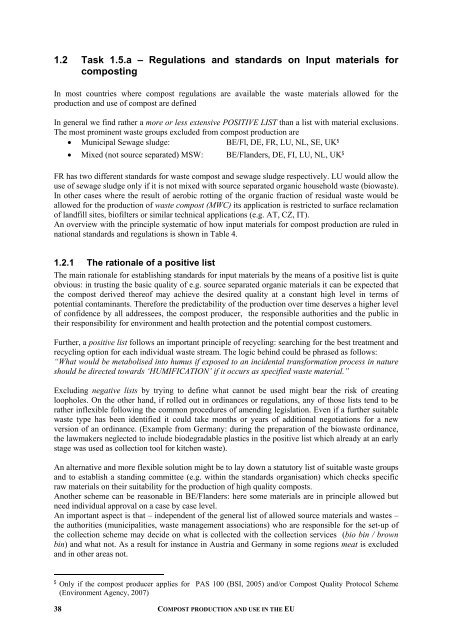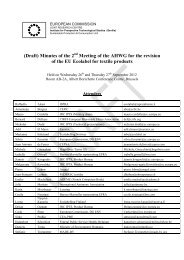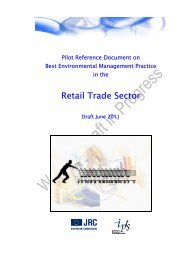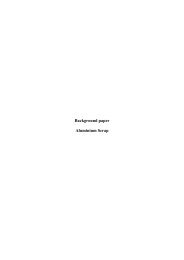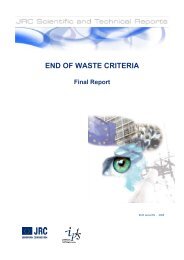final report - JRC IPTS - Sustainable Production and Consumption ...
final report - JRC IPTS - Sustainable Production and Consumption ...
final report - JRC IPTS - Sustainable Production and Consumption ...
Create successful ePaper yourself
Turn your PDF publications into a flip-book with our unique Google optimized e-Paper software.
1.2 Task 1.5.a – Regulations <strong>and</strong> st<strong>and</strong>ards on Input materials for<br />
composting<br />
In most countries where compost regulations are available the waste materials allowed for the<br />
production <strong>and</strong> use of compost are defined<br />
In general we find rather a more or less extensive POSITIVE LIST than a list with material exclusions.<br />
The most prominent waste groups excluded from compost production are<br />
• Municipal Sewage sludge: BE/Fl, DE, FR, LU, NL, SE, UK5 • Mixed (not source separated) MSW: BE/Fl<strong>and</strong>ers, DE, FI, LU, NL, UK5 FR has two different st<strong>and</strong>ards for waste compost <strong>and</strong> sewage sludge respectively. LU would allow the<br />
use of sewage sludge only if it is not mixed with source separated organic household waste (biowaste).<br />
In other cases where the result of aerobic rotting of the organic fraction of residual waste would be<br />
allowed for the production of waste compost (MWC) its application is restricted to surface reclamation<br />
of l<strong>and</strong>fill sites, biofilters or similar technical applications (e.g. AT, CZ, IT).<br />
An overview with the principle systematic of how input materials for compost production are ruled in<br />
national st<strong>and</strong>ards <strong>and</strong> regulations is shown in Table 4.<br />
1.2.1 The rationale of a positive list<br />
The main rationale for establishing st<strong>and</strong>ards for input materials by the means of a positive list is quite<br />
obvious: in trusting the basic quality of e.g. source separated organic materials it can be expected that<br />
the compost derived thereof may achieve the desired quality at a constant high level in terms of<br />
potential contaminants. Therefore the predictability of the production over time deserves a higher level<br />
of confidence by all addressees, the compost producer, the responsible authorities <strong>and</strong> the public in<br />
their responsibility for environment <strong>and</strong> health protection <strong>and</strong> the potential compost customers.<br />
Further, a positive list follows an important principle of recycling: searching for the best treatment <strong>and</strong><br />
recycling option for each individual waste stream. The logic behind could be phrased as follows:<br />
“What would be metabolised into humus if exposed to an incidental transformation process in nature<br />
should be directed towards ‘HUMIFICATION’ if it occurs as specified waste material.”<br />
Excluding negative lists by trying to define what cannot be used might bear the risk of creating<br />
loopholes. On the other h<strong>and</strong>, if rolled out in ordinances or regulations, any of those lists tend to be<br />
rather inflexible following the common procedures of amending legislation. Even if a further suitable<br />
waste type has been identified it could take months or years of additional negotiations for a new<br />
version of an ordinance. (Example from Germany: during the preparation of the biowaste ordinance,<br />
the lawmakers neglected to include biodegradable plastics in the positive list which already at an early<br />
stage was used as collection tool for kitchen waste).<br />
An alternative <strong>and</strong> more flexible solution might be to lay down a statutory list of suitable waste groups<br />
<strong>and</strong> to establish a st<strong>and</strong>ing committee (e.g. within the st<strong>and</strong>ards organisation) which checks specific<br />
raw materials on their suitability for the production of high quality composts.<br />
Another scheme can be reasonable in BE/Fl<strong>and</strong>ers: here some materials are in principle allowed but<br />
need individual approval on a case by case level.<br />
An important aspect is that – independent of the general list of allowed source materials <strong>and</strong> wastes –<br />
the authorities (municipalities, waste management associations) who are responsible for the set-up of<br />
the collection scheme may decide on what is collected with the collection services (bio bin / brown<br />
bin) <strong>and</strong> what not. As a result for instance in Austria <strong>and</strong> Germany in some regions meat is excluded<br />
<strong>and</strong> in other areas not.<br />
5 Only if the compost producer applies for PAS 100 (BSI, 2005) <strong>and</strong>/or Compost Quality Protocol Scheme<br />
(Environment Agency, 2007)<br />
38<br />
COMPOST PRODUCTION AND USE IN THE EU


